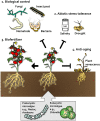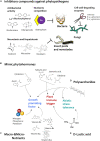Algae as New Kids in the Beneficial Plant Microbiome
- PMID: 33613596
- PMCID: PMC7889962
- DOI: 10.3389/fpls.2021.599742
Algae as New Kids in the Beneficial Plant Microbiome
Abstract
Previously, algae were recognized as small prokaryotic and eukaryotic organisms found only in aquatic habitats. However, according to a recent paradigm shift, algae are considered ubiquitous organisms, occurring in plant tissues as well as in soil. Accumulating evidence suggests that algae represent a member of the plant microbiome. New results indicate that plants respond to algae and activate related downstream signaling pathways. Application of algae has beneficial effects on plant health, such as plant growth promotion and disease control. Although accumulating evidence suggests that secreted compounds and cell wall components of algae induce physiological and structural changes in plants that protect against biotic and abiotic stresses, knowledge of the underlying mechanisms and algal determinants is limited. In this review, we discuss recent studies on this topic, and highlight the bioprotectant and biostimulant roles of algae as a new member of the plant beneficial microbiome for crop improvement.
Keywords: Chlorella; biological control; cyanobacteria; microalgae; microbiome; plant growth promotion (PGP); plant immunity.
Copyright © 2021 Lee and Ryu.
Conflict of interest statement
The authors declare that the research was conducted in the absence of any commercial or financial relationships that could be construed as a potential conflict of interest.
Figures



Similar articles
-
Strain-Specific Biostimulant Effects of Chlorella and Chlamydomonas Green Microalgae on Medicago truncatula.Plants (Basel). 2021 May 25;10(6):1060. doi: 10.3390/plants10061060. Plants (Basel). 2021. PMID: 34070559 Free PMC article.
-
Microalgae as multi-functional options in modern agriculture: current trends, prospects and challenges.Biotechnol Adv. 2018 Jul-Aug;36(4):1255-1273. doi: 10.1016/j.biotechadv.2018.04.004. Epub 2018 Apr 17. Biotechnol Adv. 2018. PMID: 29673972 Review.
-
Mitigating abiotic stress: microbiome engineering for improving agricultural production and environmental sustainability.Planta. 2022 Sep 20;256(5):85. doi: 10.1007/s00425-022-03997-x. Planta. 2022. PMID: 36125564 Review.
-
Plant Microbiome Engineering: Expected Benefits for Improved Crop Growth and Resilience.Trends Biotechnol. 2020 Dec;38(12):1385-1396. doi: 10.1016/j.tibtech.2020.04.015. Epub 2020 May 22. Trends Biotechnol. 2020. PMID: 32451122 Review.
-
Renewable Sources of Plant Biostimulation: Microalgae as a Sustainable Means to Improve Crop Performance.Front Plant Sci. 2018 Dec 7;9:1782. doi: 10.3389/fpls.2018.01782. eCollection 2018. Front Plant Sci. 2018. PMID: 30581447 Free PMC article. Review.
Cited by
-
Plants as a realized niche for Listeria monocytogenes.Microbiologyopen. 2021 Nov;10(6):e1255. doi: 10.1002/mbo3.1255. Microbiologyopen. 2021. PMID: 34964288 Free PMC article. Review.
-
Cyanobacteria-Mediated Immune Responses in Pepper Plants against Fusarium Wilt.Plants (Basel). 2022 Aug 5;11(15):2049. doi: 10.3390/plants11152049. Plants (Basel). 2022. PMID: 35956527 Free PMC article.
-
Microalgae as next generation plant growth additives: Functions, applications, challenges and circular bioeconomy based solutions.Front Plant Sci. 2023 Mar 30;14:1073546. doi: 10.3389/fpls.2023.1073546. eCollection 2023. Front Plant Sci. 2023. PMID: 37063190 Free PMC article. Review.
-
Genetic evidence for algal auxin production in Chlamydomonas and its role in algal-bacterial mutualism.iScience. 2023 Dec 16;27(1):108762. doi: 10.1016/j.isci.2023.108762. eCollection 2024 Jan 19. iScience. 2023. PMID: 38269098 Free PMC article.
-
Biotechnological Enhancement of Probiotics through Co-Cultivation with Algae: Future or a Trend?Mar Drugs. 2022 Feb 15;20(2):142. doi: 10.3390/md20020142. Mar Drugs. 2022. PMID: 35200671 Free PMC article. Review.
References
-
- Adesalu T., Olugbemi O. (2015). Soil algae: a case study of two vegetable farmlands in Lagos and Ogun states, southwest Nigeria. IFE J. Sci. 17 765–772.
-
- Ahmed M., Stal L. J., Hasnain S. (2010). Association of non-heterocystous cyanobacteria with crop plants. Plant Soil 336 363–375. 10.1007/s11104-010-0488-x - DOI
Publication types
LinkOut - more resources
Full Text Sources
Other Literature Sources
Miscellaneous

